

The strong and powerful cranes that dominate the shipping industry are part of the engineering tradition that goes back 3000 years to the highly-advanced Greek and Roman civilisations. The earliest cranes used pulleys and ropes that allowed them to lift around 6000 pounds or 3 tonnes and were operated by ten men.
The earliest cranes and even those of the medieval period employed the same basic technologies but had to be operated by manpower. They were true technological marvels of those times. Today, there are many types and sizes of cranes, but we will look at the largest gantry cranes in this article.
As the name suggests, gantry cranes are built on a gantry, a structure for straddling an object or cargo. There are many kinds of gantry cranes, like ship-to-shore cranes, full-gantry cranes, mobile gantry cranes etc., and are used for various functions like lifting massive ship engines or for the manufacture of offshore supply vessels.
Mentioned below are the six largest gantry cranes in the world.
The world’s most powerful crane is 133 metres tall and spans 120 metres, which is wider than a soccer field. It has a lifting capacity of 20,000 tonnes and holds the Guinness World Record for the heaviest weight ever lifted.
It has received many international awards, such as the Woelfel Best Mechanical Engineering Achievement Award, which recognises technologies with considerable impact on the offshore industry and meets the highest standards in terms of public health, safety concerns and environmental protocols.
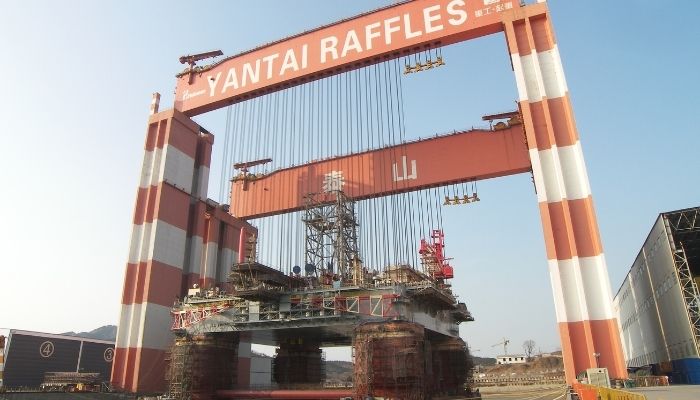

Taisun is located in Yantai, Shandong, China and is primarily used for installing large modules in semi-submersibles and FPSOs, including other offshore operations like drilling. It aids in shortening the project duration and manpower requirements while delivering the best results.
It was constructed by DHHI and holds the world record for the three heaviest lifts being 20,133 tons, 17,100 tons and 14,000 tons. In order to operate Taisun, about 50,000 m of rope is required, enabling it to lift to a maximum height of 80 m.
Constructed by the Chinese Honghua Group in 2014 in the province of Jiangsu, the Honghai is a mobile gantry crane. It became the biggest movable crane by lifting capacity, capable of lifting around 22,000 tonnes. It can reach up to a height of 65 m.
The height of this behemoth is 10 metres, and it spans 124 metres. Its steel superstructure weighs 11,000 tonnes, apart from the spreader. The crane can lift to a height of 71 metres and has 48 points for hanging or lifting, every one of them able to lift 300 tonnes. It can operate at 1800 Kilowatts and weighs about 14,800 tonnes.
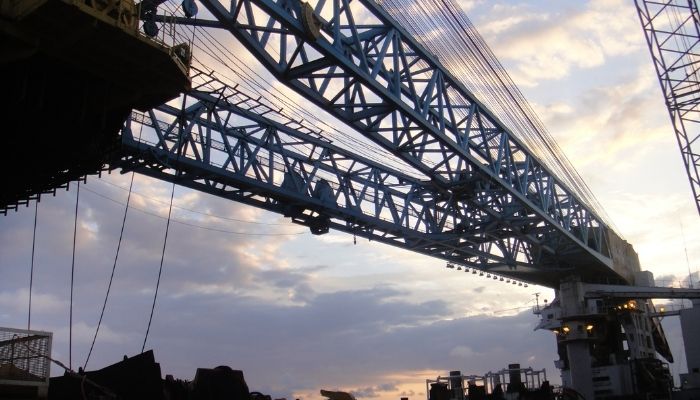

It was first commissioned in 2014 when it was used for making the hull of a platform supply vessel in a shipyard in Jiangsu. The vessel was then handed to the Danish Marine Services Company, Nordic Offshore Supply Unlimited next year. It was part of many shipbuilding projects, such as the construction of an offshore semi-submersible drilling rig for the company Orion.
Samson and Goliath are the two gantry cranes located at Queen’s Island in Belfast, Northern Ireland. Named after the biblical creatures Samson and Goliath, the two cranes can be easily identified and are, in fact, landmarks of the region.
They are located in the Harland and Wolff Shipyard on the eastern side of the Belfast Lough. A German Engineering company called Krupp designed and constructed them. Goliath was built in 1969, whereas Samson was completed in 1974.
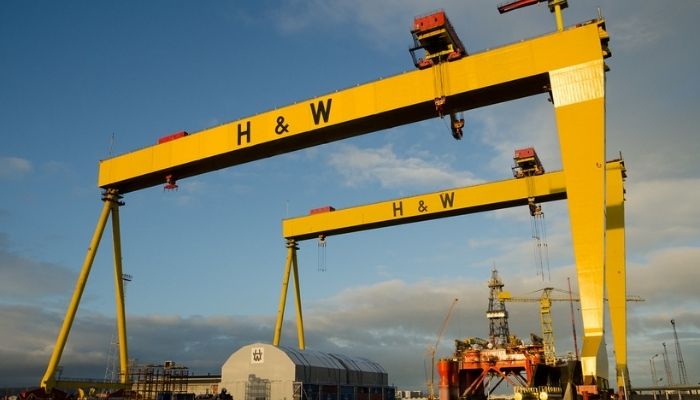

Goliath is about 315 feet or 96 metres tall, whereas Samson is about 106 metres or 348 feet. Goliath is smaller and is situated inland, towards the city of Belfast. Both of them have a 140 metres span ad can lift around 840 tons at the height of 70 m or 230 feet. Hence, they have a combined lifting capability of about 1600 tonnes, which is one of the largest in the world.
Before the cranes were put to work, they were adequately tested to lift a weight of 1000 tonnes which bent them forwards by 30 cm. A dry dock at their bases is also the eleventh largest worldwide.
One of the ministers of Ireland stated that the cranes are an essential part of the city, its culture and its heritage. They were not buildings but are listed under buildings of architectural or historical interest by the Environmental Agency.
The world’s biggest Goliath gantry crane is situated in the Rio Grande do Sul, Brazil. It can lift 2000 tonnes and has a rail span of around 210 m. It was made on the order of Ecovix and was constructed by a renowned lifting and construction equipment provider, Konecranes.
Though the order was received in 2011, it was delivered only recently in 2020. The construction of its components was carried out in South Korea and Finland. It would be initially used for assembling the hulls of FPSO ships employed in oil production projects.
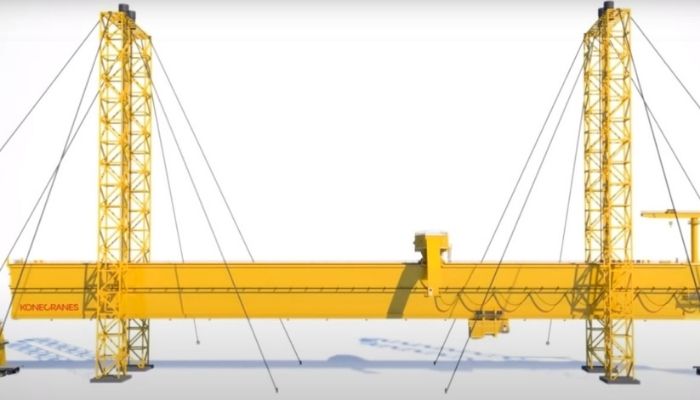

Per the officials, the Goliath gantry crane will increase productivity in the Polo Naval do Rio Grande shipyard, famous for having the largest drydock in Latin America. Hence, the crane would add to its competitiveness and allow it to face the challenges of vessel assemblage with high technologies for domestic and international markets.
The three cranes are the largest of their kind in the world and are part of the historic port expansion and upgradation project. The port authorities envisage that they would help the growth of local businesses so they can make a reputation in global markets. They would also make the Port of Everglades competitive.
Each crane is 175 feet or 53 metres tall and costs 13.8 million US dollars. It can easily handle the containers stacked in the vessel’s deck area and reach 22 containers across the deck.
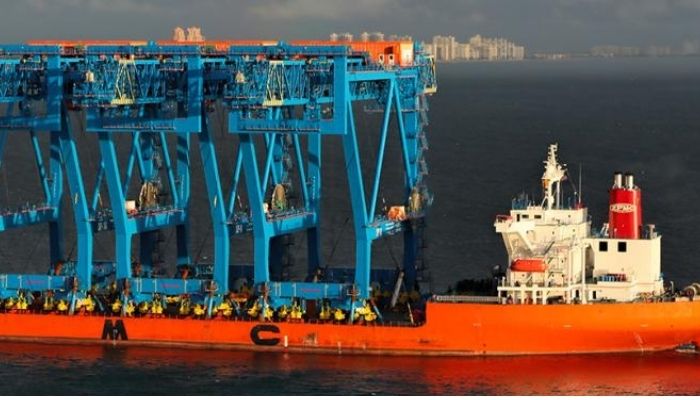

They were designed and constructed by Shanghai Zhenhua Heavy Industries Co. Ltd. Inc. They are low-profile crane models that extend outwards rather than upwards due to their proximity to the Fort Lauderdale International Airport, less than 2 miles from the cranes’ position.
All three cranes have a special lighting technology that decreases the light and limits the light that spreads on the ground to protect the nesting area of sea turtles.
The Kockums Gantry Crane was constructed between 1973 and 1974 to support the shipbuilding process at the Kockums shipyard in Malmo, Sweden. It is 140 metres or 459 feet long and can lift 1500 tons.
However, it is much more than a mere crane. It became a centre of attraction for the people of Sweden and pride for the residents of Malmo when it was first constructed. People from near and far came to have a glance at the crane.
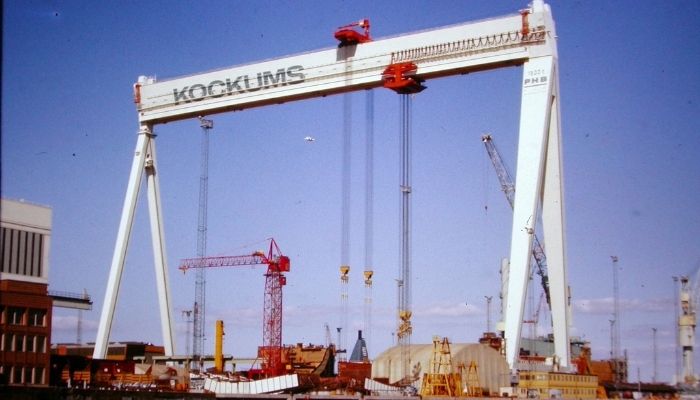

It was taken to South Korea in 2002 and became one of the many goliath cranes at Ulsan Hyundai Heavy Industries shipyards. It also earned the nickname ‘Tears of Malmo’ at the same time. It is believed that the inhabitants of the Swedish shipping town cried and wept when their crane was being taken away to be dismantled. Although the kockums crane does not have a world lifting record, it is one of the most popular cranes in the world.
The crane is 453 feet tall and was used to construct 75 ships. The gauge of its rails was 174 m, and the length of th rails was 710 m, respectively. Before being towed away, it was used in 1997 for lifting the foundations of the pillars of the Oresund Bridge in Malmo.
The historic crane was sold to Burmeister and Wain, based in Denmark. However, the company went bankrupt, so the crane could not be moved. Ultimately it went to HHI.
You might also like to read-
Disclaimer: The authors’ views expressed in this article do not necessarily reflect the views of The Marine Learners. Data and charts, if used, in the article have been sourced from available information and have not been authenticated by any statutory authority. The author and The Marine Learners do not claim it to be accurate nor accept any responsibility for the same. The views constitute only the opinions and do not constitute any guidelines or recommendations on any course of action to be followed by the reader.
The article or images cannot be reproduced, copied, shared, or used in any form without the permission of the author and The Marine Learners.










We believe that knowledge is power, and we’re committed to empowering our readers with the information and resources they need to succeed in the merchant navy industry.
Whether you’re looking for advice on career planning, news and analysis, or just want to connect with other aspiring merchant navy applicants, The Marine Learners is the place to be.